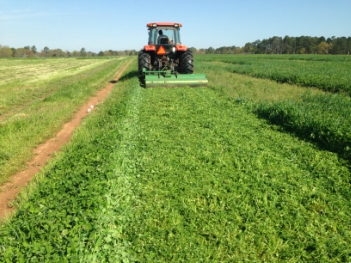Termination with Mowing and Incorporation

Flail mower.
While many production systems in the Southern region utilize no-till practices, tillage is common in some production systems. Many organic producers mow and then incorporate their cover crops. Mowing and incorporation can kill a cover crop when it is young; however, cover crops are easier to kill when they have entered a reproductive stage even with this method. Cover crops should be mowed as close to the ground surface as possible to encourage the plant to die. In general, flail mowers do a better job than rotary mowers. Flail mowers chop the cover crop residue more finely and drop the residue more evenly in place. Rotary mowers tend to leave large clumps of residue that may be more difficult to incorporate.
Incorporation of the cover crop residues with tillage is the second step in this operation. The mowed cover crop should be incorporated immediately or within a couple of days after mowing to begin the decomposition process before planting the cash crop.
Growers are advised to match their tillage equipment to the cover crop biomass produced. Put another way, growers who plan to rely on tillage to terminate cover crops are advised to not produce more cover crop biomass than they can handle with their tillage equipment. For example, large amounts of small grain cover crop biomass will need an initial pass with a coarse tillage implement like a heavy tandem disk harrow to terminate and initially incorporate it. Depending on the cash crop being grown, several secondary tillage passes may be needed to prepare adequate seedbeds. Growers should also remember that the aboveground biomass is only part of the cover crop. The tillage equipment will also need to handle the root biomass. Small grain cover crops can produce copious amounts of fibrous roots.
In some cases, tillage is required to reap all benefits desired from a cover crop. For instance, brassicas contain isocyanates that reduce harmful nematode populations, if flail mowed and incorporated into the soil immediately.
More Information:
- A Simple Guide for Conservation Systems in the Southeast. USDA ARS
- Termination of Cover Crops: Management Considerations for the Subsequent Cash Crop. Conservation Systems Fact Sheet No. 11. USDA ARS
Contributors:
Dr. Charlie Cahoon, Extension Specialist, Virginia Tech; Dr. Stanley Culpepper, Extension Specialist, University of Georgia; Dr. Mike Flessner, Extension Specialist, Virginia Tech; Julia Gaskin, Extension Specialist, University of Georgia; Dr. Erin Haramoto, Assistant Professor, University of Kentucky; Dr. Andy Price, USDA Agricultural Research Service; Dr. Mark Reiter, Extension Specialist, Virginia Tech; Dr. William Vencill, Professor, University of Georgia
